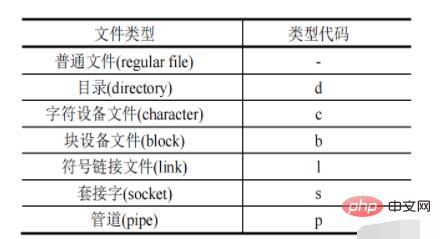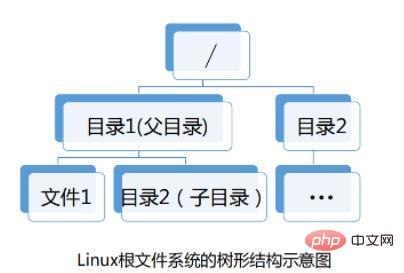Where is the Linux directory entry
Linux directory entries are in the file directory. In Linux, the file directory is used to identify the physical address of the file in the system and is provided for retrieving files. The file directory entry contains the file name and i-node number. .

#The operating environment of this tutorial: linux5.9.8 system, Dell G3 computer.
Where are the Linux directory entries?
Linux files and directories, directory entries in Linux
File path Path Example: /home/user/test.txt
Relative path: Starting from the current directory to the path to the target file or directory Example: Under the home path, writing uesr/test.txt cannot be written /user/test.txt- Attributes of the file
- File type


- 1)~ represents the user’s home directory
- 2). represents the current directory
File name3).. Represents the upper-level directoryfile directory: used toidentifyin the system File physical address , provided for retrieving files.The file directory entries include:
- ,
- i node number
- Linux directory structure (tree structure)

- File System Hierarchy Standard (FHS)

- /: The starting point of the linux system directory tree bin: Command file directory
 boot: Stores the system's
boot: Stores the system's
dev:Device files Directory, stores all device files, such as cdrom is a CD device
etc: storessystem configuration files, such as password files
home: contains the home directoryof each user in the system , and the subdirectory name is each user Name
lib: Stores various programming language librariesmedia: The automatic mounting point set by the system, such as the automatic mounting point of a U disk
opt: Indicates optional Meaning, somesoftware packages will be installed here
usr: one of the largest directories. In many systems, this directory is mounted as an independent partition.Mainly stores data that does not change frequently
, as well as the application directory installed under the systemmnt: Mainly used totemporarily mount the file system, provided by default for some devices Mount point
proc: virtual file system, the files in this directory are images in memorysbin: save the command file of the system administrator or root user
tmp : Store temporary filesvar : Usually save frequently changing content, such as system logs, mail files, etc.
root : System administrator directoryRelated recommendations: "
Linux Video Tutorial"
The above is the detailed content of Where is the Linux directory entry. For more information, please follow other related articles on the PHP Chinese website!

Hot AI Tools

Undresser.AI Undress
AI-powered app for creating realistic nude photos

AI Clothes Remover
Online AI tool for removing clothes from photos.

Undress AI Tool
Undress images for free

Clothoff.io
AI clothes remover

Video Face Swap
Swap faces in any video effortlessly with our completely free AI face swap tool!

Hot Article

Hot Tools

Notepad++7.3.1
Easy-to-use and free code editor

SublimeText3 Chinese version
Chinese version, very easy to use

Zend Studio 13.0.1
Powerful PHP integrated development environment

Dreamweaver CS6
Visual web development tools

SublimeText3 Mac version
God-level code editing software (SublimeText3)

Hot Topics
 1668
1668
 14
14
 1426
1426
 52
52
 1328
1328
 25
25
 1273
1273
 29
29
 1255
1255
 24
24
 Linux Architecture: Unveiling the 5 Basic Components
Apr 20, 2025 am 12:04 AM
Linux Architecture: Unveiling the 5 Basic Components
Apr 20, 2025 am 12:04 AM
The five basic components of the Linux system are: 1. Kernel, 2. System library, 3. System utilities, 4. Graphical user interface, 5. Applications. The kernel manages hardware resources, the system library provides precompiled functions, system utilities are used for system management, the GUI provides visual interaction, and applications use these components to implement functions.
 vscode Previous Next Shortcut Key
Apr 15, 2025 pm 10:51 PM
vscode Previous Next Shortcut Key
Apr 15, 2025 pm 10:51 PM
VS Code One-step/Next step shortcut key usage: One-step (backward): Windows/Linux: Ctrl ←; macOS: Cmd ←Next step (forward): Windows/Linux: Ctrl →; macOS: Cmd →
 How to check the warehouse address of git
Apr 17, 2025 pm 01:54 PM
How to check the warehouse address of git
Apr 17, 2025 pm 01:54 PM
To view the Git repository address, perform the following steps: 1. Open the command line and navigate to the repository directory; 2. Run the "git remote -v" command; 3. View the repository name in the output and its corresponding address.
 How to run java code in notepad
Apr 16, 2025 pm 07:39 PM
How to run java code in notepad
Apr 16, 2025 pm 07:39 PM
Although Notepad cannot run Java code directly, it can be achieved by using other tools: using the command line compiler (javac) to generate a bytecode file (filename.class). Use the Java interpreter (java) to interpret bytecode, execute the code, and output the result.
 How to run sublime after writing the code
Apr 16, 2025 am 08:51 AM
How to run sublime after writing the code
Apr 16, 2025 am 08:51 AM
There are six ways to run code in Sublime: through hotkeys, menus, build systems, command lines, set default build systems, and custom build commands, and run individual files/projects by right-clicking on projects/files. The build system availability depends on the installation of Sublime Text.
 What is the main purpose of Linux?
Apr 16, 2025 am 12:19 AM
What is the main purpose of Linux?
Apr 16, 2025 am 12:19 AM
The main uses of Linux include: 1. Server operating system, 2. Embedded system, 3. Desktop operating system, 4. Development and testing environment. Linux excels in these areas, providing stability, security and efficient development tools.
 laravel installation code
Apr 18, 2025 pm 12:30 PM
laravel installation code
Apr 18, 2025 pm 12:30 PM
To install Laravel, follow these steps in sequence: Install Composer (for macOS/Linux and Windows) Install Laravel Installer Create a new project Start Service Access Application (URL: http://127.0.0.1:8000) Set up the database connection (if required)
 git software installation
Apr 17, 2025 am 11:57 AM
git software installation
Apr 17, 2025 am 11:57 AM
Installing Git software includes the following steps: Download the installation package and run the installation package to verify the installation configuration Git installation Git Bash (Windows only)




